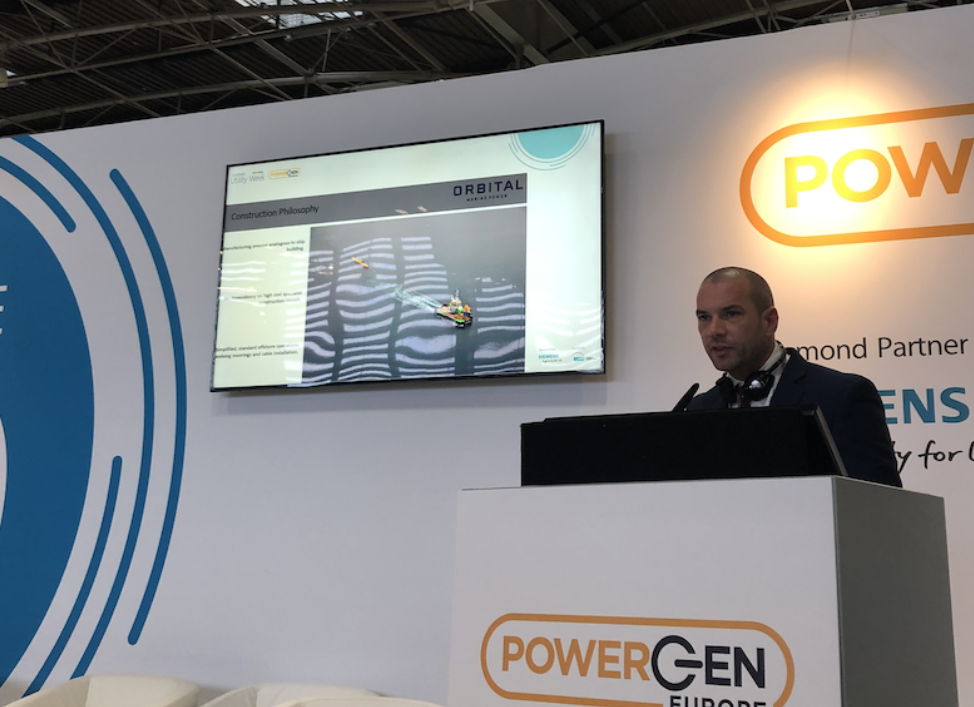
In a session called “Emerging Renewable Energy Technologies,” at POWERGEN Europe, three different tidal energy solution providers delivered the message that tidal energy has a place in the energy mix of tomorrow.
Drew Braxland, Director with Atlantis Turbines and Engineering Services gave the audience a glimpse at the Raz Blanchard pilot array in Normandy, France. It’s a 4-turbine project with installed capacity of 1.5 MW. The four turbines are each connected to one hub and connected to the grid by a single cable.
Blaxland emphasized that servicing the turbines, despite that fact that they are underwater, is not an issue. He said his company has proved that it can connect a turbine to the grid in 30 minutes and when performing O&M, the turbine can be lifted from the sea, serviced on the deck of a boat and returned to the ocean in under 24 hours.
Blaxland said the market potential for tidal energy is near 100 GW.
Chris Milne, CFO of Orbital Marine then presented his company’s solution for floating tidal energy. He began by saying that the tidal energy industry had overpromised and underdelivered in the past and that he and his fellow presenters were here to say that tidal energy has improved.
“We are doing our bit now to prove that this is commercial technology that is deployable at scale,” he said.
Orbital marine’s device sits on top of the water and its turbines, which appear as wings, are lowered into it. These “wings” capture energy from the movement of the water. The technology is similar to propulsion on a boat but in reverse, with the movement of the water turning stationary turbines instead of vice versa.
Milne said that the installed cost of tidal energy from Orbital’s solution is in line with that of offshore wind and that O&M for the device, since it is floating, is in line with that of onshore wind. Special boats are not required to maintain the device as any service boat can be commissioned to bring technicians to the site, who then walk right onto it and situate themselves within it to work on it.
Milne said that levelized cost of energy, LCOE, will be less than 100 pounds per megawatt-hour. He added that the public is in favor of tidal energy but said that policymaker support is still needed.
Terji Nielsen, Head of R&D with SEV, a utility on the Faroe Islands, presented next. He explained how subsea kites are helping the islands achieve their 100 percent renewable energy goal. Nielsen explained that the Faroe islands get a lot of wind and rain in the winter, so wind power and hydropower are important. In the summer, he said, they get a lot of sun, making solar power highly valuable.
Neilsen said that there are three straits in the islands and if they deploy tidal energy devices in all three, the energy becomes almost baseload.
Martin Edlund, CEO with Minestro AB then gave an overview of the technology and costs associated with deploying it. Deep Green, the name of the technology, uses underwater kites to produce energy.
Edlund explained that the technology is publicly funded via various grants from the Swedish government. For now the company is targeting the Faroe islands. Edlund explained that as a smaller community, decisions can be made quickly and the entire community is focused on the 100 percent renewable goal, which makes it an easy community to work with. He said it has been interesting to compare the cost of getting to 100 percent renewable energy with and without tidal energy.
Rounding out the Emerging Renewable Energy Technologies session was a look at the global offshore wind market from Alberto Toril from the IEA and a glimpse at self-consumption of PV in France, given by Enedis’ Marc Gratton.